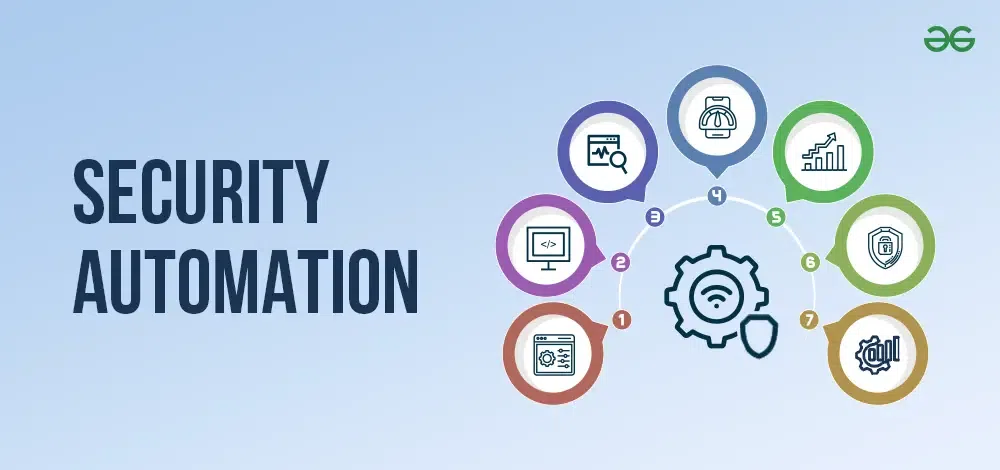|
Security automation is revolutionizing the field of cybersecurity, providing businesses with advanced tools to enhance their defenses against cyber threats. Security automation uses technology to automate cybersecurity which speeds up threat detection, incident response, and vulnerability management, making security more effective. By implementing security automation for automating routine tasks, organizations improve their security and response times, letting security teams focus on important jobs organizations can also improve efficiency, reduce human error, and respond to incidents faster.
Security automation works by recognizing risks to an organization’s security posture, sorting and triaging them, assigning a priority level, and then responding to each one in turn. Security automation helps to streamline the numerous notifications that security professionals get regularly.
This article explores the importance of security automation, its key benefits, and the technologies that drive it.
What is Security Automation?
Security Automation is the process of automatically identifying, investigating, and remediating cyber threats, with or without human interaction. Security automation uses technology to automatically handle tasks in cybersecurity that are traditionally done manually. This includes automating processes like threat detection, incident response, and vulnerability management. Current security automation software can do all of these operations in seconds, frequently without the need for the security team’s interaction and free them from repetitive, laborious, and time-consuming tasks. By automating these tasks, organizations can improve their overall security posture, respond faster to cyber threats, and free up security teams to focus on more strategic initiatives.
 Security Automation Types of Security Automation
- SIEM: Security information and event management (SIEM) systems analyze log data for patterns that could indicate a cyberattack, then provide micro automation capabilities to correlate event information across devices to identify possibly unusual activity and finally, send a warning.
- SOAR: Security Orchestration Automation and Response (SOAR) technologies frequently depend on SIEM infrastructure for data intake. After collecting, correlated, and enhanced, the data is utilized in SOAR playbooks, case management, and incident reporting.
- No-Code Automation Tools: No-code is a software applications development process without the programming languages. These services can automate basic workflows, but can not provide comprehensive end-to-end use case automation.
- XDR: Extended detection and response is a security automation type to detect and minimize cybersecurity risks. XDR enables faster threat detection and enhanced investigation and response times via security automation.
Technologies in Security Automation
- Artificial Intelligence (AI) and Machine Learning (ML): AI and ML algorithms analyze vast amounts of data to identify patterns and anomalies, enhancing threat detection and predictive analytics.
- Security Orchestration, Automation, and Response (SOAR): SOAR platforms integrate and automate various security tools and processes, enabling cohesive and efficient incident management.
- Intrusion Detection and Prevention Systems (IDPS): Automated IDPS monitor network traffic for suspicious activities and take predefined actions to prevent intrusions.
- Endpoint Detection and Response (EDR): EDR solutions provide continuous monitoring and automated response capabilities for endpoint devices, improving overall endpoint security.
- Automated Vulnerability Management: Automated tools scan systems for vulnerabilities, prioritize them based on risk, and initiate remediation processes.
Benefits of Security Automation
Below are some benefits of security automation
- Increased Efficiency: Security automation reduces the time and effort required to perform routine security tasks, allowing security teams to focus on more strategic activities.
- Improved Accuracy: Automated systems minimize human errors, ensuring that security processes are executed consistently and accurately.
- Faster Incident Response: Automation enables rapid detection and response to security incidents, mitigating potential damage and reducing downtime.
- Scalability: Security automation solutions can easily scale to handle large volumes of data and security events, making them suitable for organizations of all sizes.
- Cost Savings: By automating repetitive tasks, organizations can reduce operational costs and allocate resources more effectively.
Need of Security Automation
- Increased Attack Frequency: The frequency of cyber attacks has surged, making manual security processes insufficient to keep pace.
- Complex Threat Landscape: Cyber threats are becoming more complex and multi-faceted, requiring advanced solutions to detect and mitigate them effectively.
- Human Error: Manual security processes are prone to errors, which can lead to significant vulnerabilities.
- Resource Intensive: Manual monitoring and response are time-consuming and require substantial human resources, diverting attention from strategic initiatives.
- Delayed Response: Human-led incident response is often slower, allowing cyber threats to inflict more damage before they are contained.
Challenges for Security Automation
Below are some risks of security automation
- Complexity: Implementing security automation can be complex and requires careful planning and integration.
- False Positives: Automated systems may generate false positives, which need to be managed to avoid unnecessary disruptions.
- Human Oversight: Despite automation, human oversight is essential to handle exceptions and ensure the system operates correctly.
- Cost: The initial investment in security automation tools and technologies can be significant, but it is often offset by long-term benefits.
Conclusion
Security automation is essential in modern cybersecurity, automating tasks like threat detection, incident response, and vulnerability management. This speeds up response times and enhances overall security, allowing teams to focus on strategic initiatives. Embracing security automation is crucial to protect sensitive information and ensure business continuity in today’s digital landscape.
Frequently Asked Questions on Security Automation – FAQs
How does automation help with security?
Automation removes multiple manual processes and alarms, allowing SOC analysts to do repetitive security jobs much more quickly.
How does security automation work without human intervention?
Security automation integrates safety processes, apps, and infrastructure to reduce the need for human involvement.
Is Security automation necessary?
Security automation is necessary due to the increasing complexity and frequency of cyber threats. It enhances efficiency, accuracy, and speed in threat detection and response, crucial for maintaining robust cybersecurity defenses.
|

